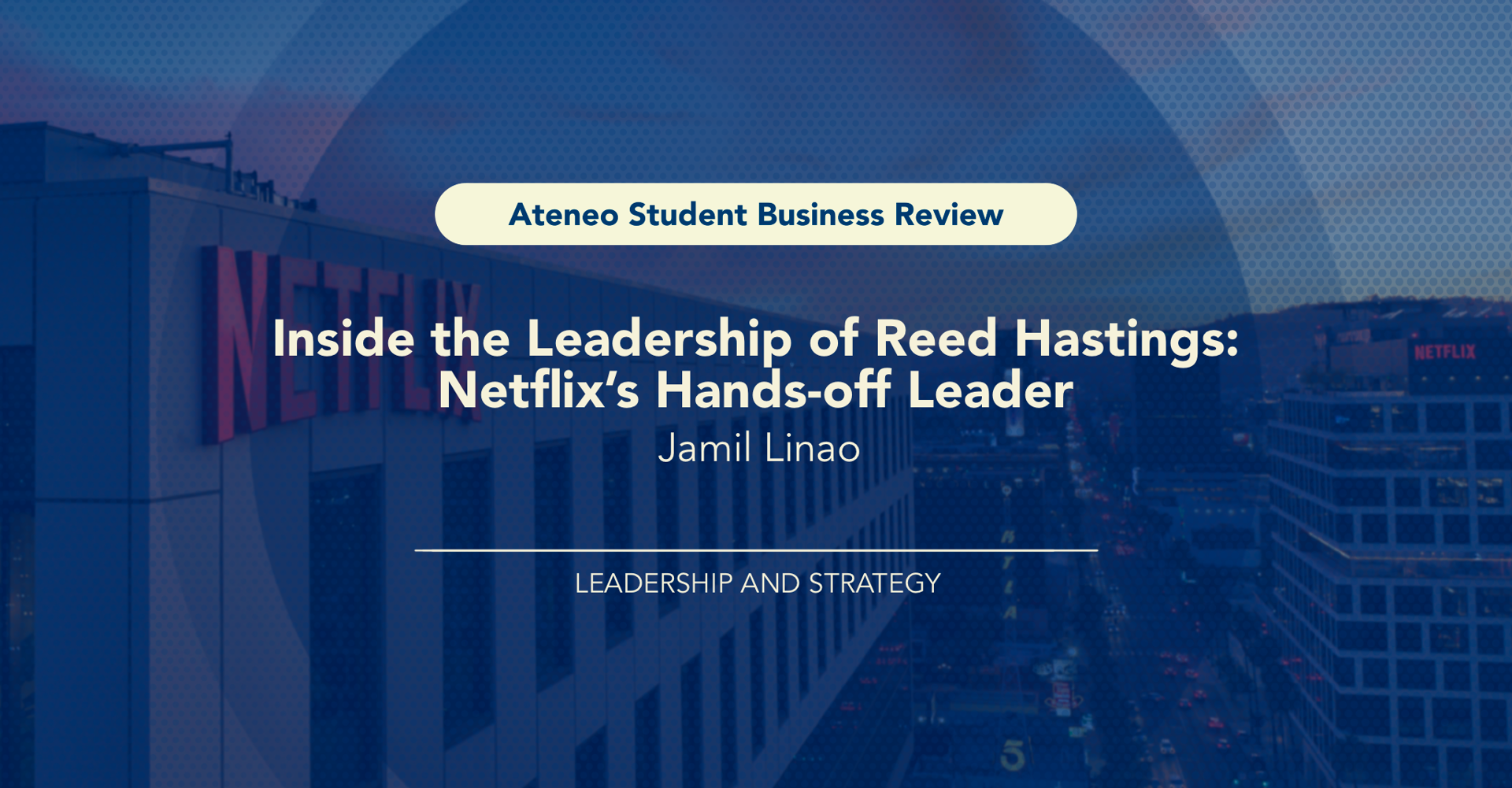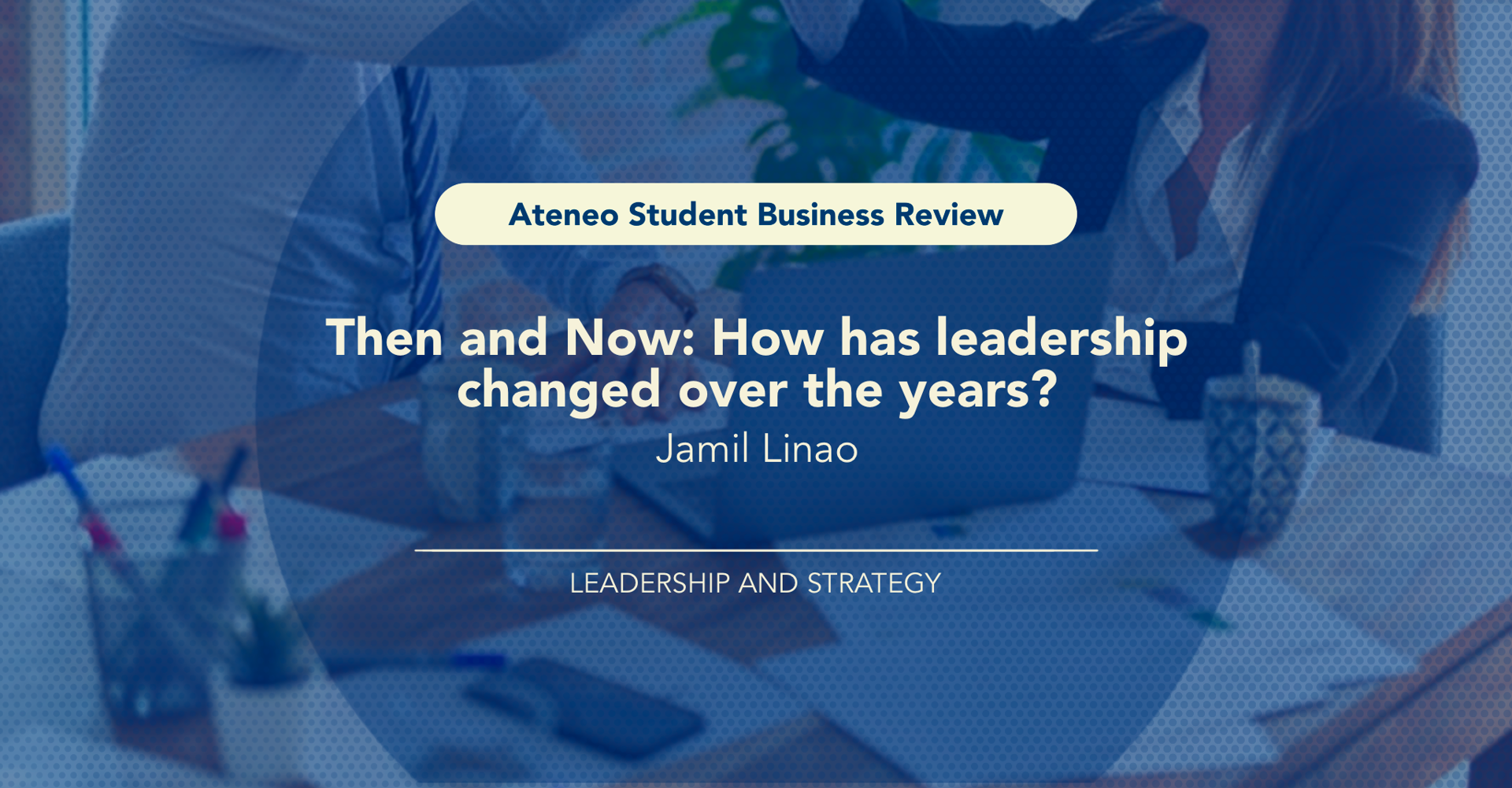Inside the leadership of Reed Hastings: Netflix’s hands-off leader
By Jamil Linao
A laissez-faire leadership. That is how Nolan McAndrew of the University of Connecticut describes Reed Hastings’ leadership in his paper, “Assessing Leadership in Business – Marketing: A Critical Investigation of Reed Hastings.”
Developed by psychologist Kurt Lewin in the 1930s, laissez-faire leadership sets trust and reliance as its core virtues. In this leadership approach, individuals are encouraged to operate autonomously without explicit orders from their superiors. Although viewed by many as overly lax and “likely to result in miscommunication and reduced productivity,” this is not the situation in Netflix. McAndrew pinpoints two reasons why:
Netflix focuses on high performance and openness; and
Reed Hastings installs in Netflix a clear blueprint of its future.
While these reasons appear broad, we examine how Netflix avoids falling into pitfalls with such a high-risk leadership style. We likewise look at Netflix’s opportunities for growth and cite incidents where they could have acted more prudently.
The culture in Netflix
Hastings takes pride in being a “very” hands-off leader. He regards his primary role as the firm’s Chief Executive Officer to be “vision setting.” He keeps out of day-to-day decision-making, spends approximately six weeks off a year for vacation, and essentially delegates Netflix's everyday operations to his people.
The culture in Netflix is centered around four core values: worker empowerment, transparency, a dream team mentality, and direct and honest feedback. Netflix’s culture deck heading, “Context, not control,” best articulates the organization’s emphasis on employee empowerment. Bosses and managers at Netflix are expected to provide employees with everything they need to make well-informed decisions. This is instead of making every decision for the employees themselves, or simply, micromanaging.
Furthermore, staff spending, travel, and gifts are never monitored or controlled. The guidelines set for Netflix employees are only to "act in Netflix's best interests" and "use good judgment.” Lindsay Harriss, writer for CIPHR, believes that this independence is beneficial in Netflix’s exceptional organizational performance and cites an Oxford Academic article on the positive correlation between focus on self-management and autonomy and employee well-being and work happiness.
Another advantage of delegating crucial decision-making to lower-level personnel is that it prepares them to make rapid judgments in times of crisis, allowing Netflix to react to external pressures more quickly. Jake Wilder of Medium explains that Netflix establishes these norms and processes primarily to avoid repeating the mistakes Hastings himself witnessed, and for which he was partially responsible, at Pure Software regarding an over-reliance on the process. They have proven to be highly effective in building an innovative culture at Netflix.
Netflix also makes a deliberate effort to achieve flexibility among its people. They believe that as companies grow, they become highly centralized and inflexible. One reason why this happens is that the company management is involved in a teeming number of small decisions—they are micromanaging. Netflix avoids this by being “Highly Aligned, and Loosely Coupled,” which implies that its people do not need to seek approval from their superiors to execute a move. In its culture deck, they declare that in Netflix, the end goal is “to grow the business for bigger impact while increasing flexibility and agility. We seek to be big, fast, and nimble.”
The success of Netflix
With millions of people stuck at home during the pandemic, Netflix’s market capitalization rose to as high as US$306 billion. In the first nine months of 2020, they reported an increase of 26 million new users. Netflix recorded a $24.9 billion in revenue during the first year of the pandemic. In the final quarter of 2021, Netflix’s financial reports tally US$7.7 billion in revenues, indicating a 25% year-on-year growth. Their annual income last year? US$30 billion. Hastings believes that all these successes are primarily attributed to the culture they cultivate in Netflix.
Hastings also acknowledges the risk of granting a great deal of autonomy to his people. But he believes that because innovation and creativity both hold significant value in the success of Netflix, this leadership style is deemed the most conclusive. In an interview with media organization National Public Radio, he said, “It’s risky trusting employees as much as we do. Giving them as much freedom as we do. But it’s essential in creative companies where you have much greater risk from lack of innovation.”
Is the Netflix culture for everyone?
The short answer is no.
Truth be told, there is a solid case to say that the Netflix culture is not for Netflix itself. Writers Shalini Ramachandran and Joe Flint of The Wall Street Journal cite direct criticisms of Netflix for “its perceived overuse of feedback and transparency, particularly when it comes to employee firings.” Consequently, outside critics and Netflix workers themselves have criticized Hastings’ apparent lack of emotional intelligence and delayed reactions to cultural sensitivity.
Under Hastings’ leadership, Netflix has become subject to criticism and notoriety because of the way they let go of their employees. Because it prides itself on cultivating a culture of feedback and transparency, Netflix sends emails to its staff when employees are fired. Ramachandran and Flint mention that “The emails about firings can reach hundreds of employees across multiple divisions and can be painfully specific” (“At Netflix, Radical Transparency and Blunt Firings Unsettle the Ranks,” The Wall Street Journal, 25 Oct 2018). In theory, these employee firing announcements were meant to “serve as a learning point” for Netflix employees. However, this only reflected the side of the Netflix management and not that of the fired employee. Furthermore, McAndrew points out that one-sided dialogues hinder employees from echoing their perspectives, and worse, can even trigger gossip among Netflix employees.
Critics also pinpoint the Netflix hands-off approach as the culprit of the infamous handling of Jonathan Friedland, Netflix’s former Chief Communications Officer. McAndrew mentions that Friedland used the derogatory N-word twice in meetings over four months. Matt Donnelly of Variety notes that Friedland’s actions were met with “wide complaints from the staff,” and one former employee even stated that “[Friedland] should have been fired right away, not months later.” Friedland was only fired months after the original complaints about his usage of the derogatory phrase reached Hastings's office. Although Hastings recognized that the Netflix management could have dealt with the Friedland situation more adeptly, it is still undeniable that Hastings’ hands-off style contributed to this mishap.
McAndrew also speaks of Netflix’s practice of allowing executives to see the salaries of all employees. He believes that this is yet another point of contention in Netflix’s handling of transparency. Bryn Sandberg of The Hollywood Reporter substantiates this by stating in an article, “As of 2017, anyone director-level or above can see what everyone makes (and their pay history) through an internal system called Workday.” This initiative is supposed to provide managers with information on determining which employees deserve raises and which do not. One of the negative consequences of salary transparency to higher-level employees is that it creates jealousy among executives and leaves “lower-level employees regarding what they earn in comparison to their colleagues.” While Netflix has taken steps toward a level of transparency that seeks to benefit all its employees, these reforms are not yet far-reaching enough to help anybody other than the company's already-elite upper-level management members.
Moving forward
Hastings’s style leadership is far from perfect. Dubbed as a leader “unencumbered by emotion” by his colleagues and remarked by a Netflix vice president as a bad listener and unempathetic, the billionaire entrepreneur has a long way to tread. Two areas that Netflix management can consider are empathy and emotional intelligence. McAndrew says the most prominent streaming company can achieve these by “listening to the complaints of employees who call for better handling of racial issues, freely sharing the salaries of all employees to prove a commitment to equality and transparency, ensuring that feedback does not cross the line from constructive to critical, and keeping details on why employees were fired exclusively to the teams that their severance directly affects.”
These, however, do not take away what outstanding accomplishments Netflix has made because of Hastings and his brand of leadership. The clear vision he sets, for example, encourages the people in Netflix to create goals not just for themselves but for the company as well. Their prioritization of flexibility also advantaged them at a time when every one of their employees is working remotely from home. The benefits of Hastings’ leadership undoubtedly outweigh the negatives.
The good news is that the negatives can always be addressed as long as Hastings is willing to learn. And he is. In fact, for him, “feedback is like exercise, and it is always the last push-ups that make you stronger.” He cannot get a better start than that.
More Articles
Then and Now: How has leadership changed over the years?
by Jamil Linao | December 6, 2021
Today’s leaders are trained not only to manage their subordinates but also to help them grow and develop. This was not the case twenty years back.
Cloud Storage: The Basics
by Raphael Llagas | December 6, 2021
An overview of the advantages and disadvantages of cloud storage, the types of cloud storage, and services integrated with everyday life.
Sustainability and Inclusive Growth
Basics of Sustainability
by Bea GoBio | March 7, 2022
How often have you heard the word “sustainability” and immediately associated it with just the environment? You may be surprised to know that there are more aspects of sustainability than simply environmental sustainability.
Copyright © 2021 ASBR JGSOM | All rights reserved.



